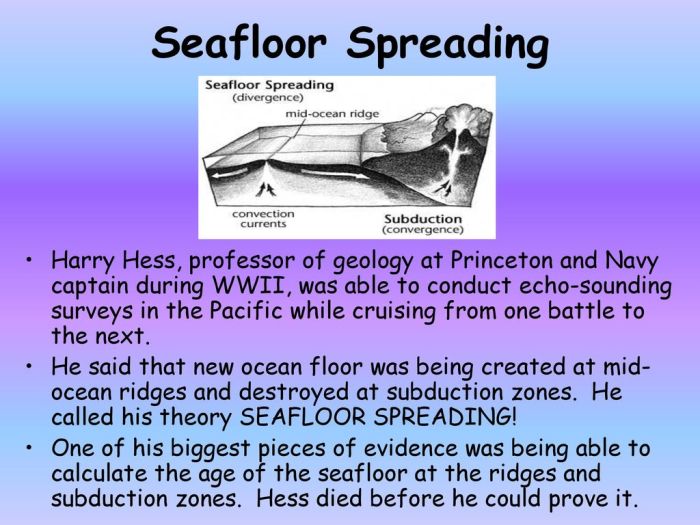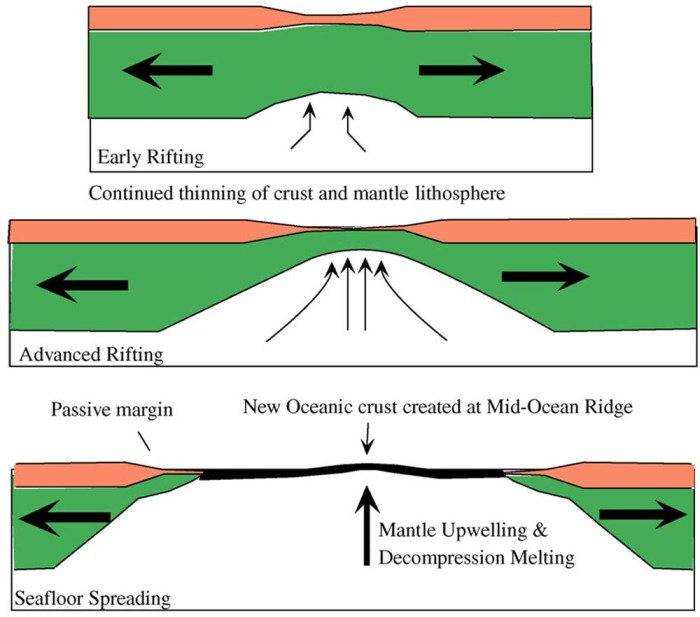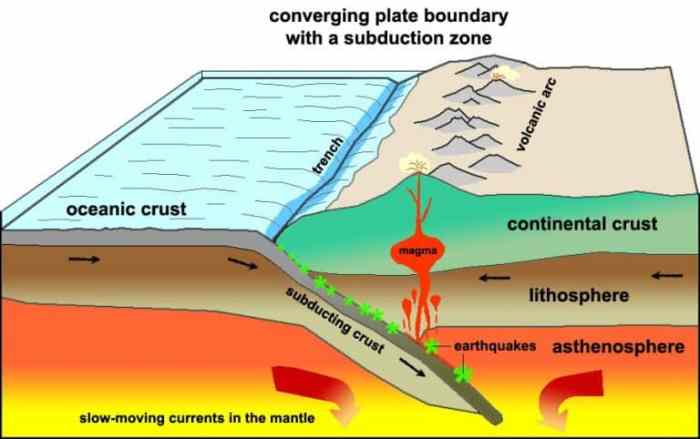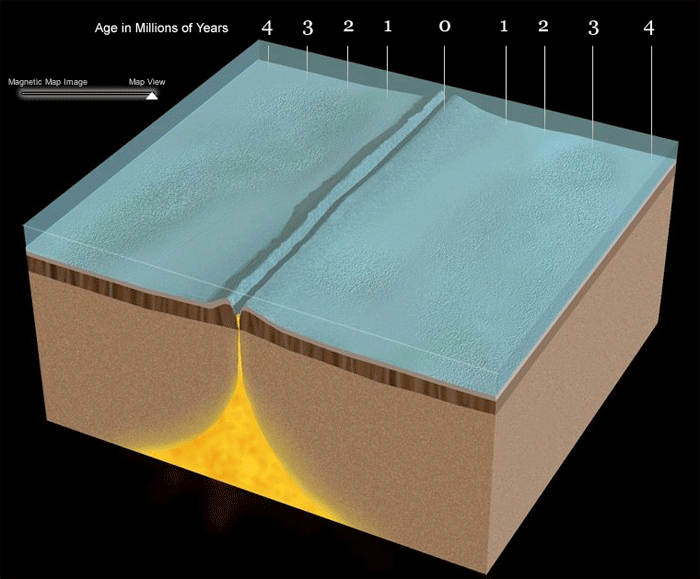Which statement describes the cyclic nature of seafloor spreading? This question delves into the fascinating process of seafloor spreading and its cyclical nature, providing a deeper understanding of plate tectonics and Earth’s dynamic history.
Seafloor spreading is a fundamental process in plate tectonics, involving the creation of new oceanic crust at mid-ocean ridges and its subsequent destruction at subduction zones. This ongoing cycle shapes the Earth’s surface, drives continental drift, and plays a crucial role in the planet’s geological evolution.
1. Define the Cyclic Nature of Seafloor Spreading

Seafloor spreading is the process by which new oceanic crust is formed at mid-ocean ridges and moves away from them, creating new ocean floor. This process is cyclical, as the crust that is created at the ridges is eventually recycled back into the mantle at subduction zones.
Explain the process of seafloor spreading and its cyclical nature.
Seafloor spreading occurs when hot material from the mantle rises up to the surface of the Earth at mid-ocean ridges. This material cools and solidifies to form new oceanic crust. The new crust is then pushed away from the ridge by the force of the mantle convection currents.
As the crust moves away from the ridge, it cools and becomes denser. Eventually, it reaches a point where it is denser than the surrounding mantle and sinks back into the mantle at subduction zones.
Discuss the role of plate tectonics in seafloor spreading.
Seafloor spreading is driven by plate tectonics. Plate tectonics is the theory that the Earth’s crust is divided into a number of plates that move around the surface of the Earth. The plates are made up of the continental crust and the oceanic crust.
The oceanic crust is created at mid-ocean ridges and the continental crust is created at convergent plate boundaries.
Provide examples of seafloor spreading ridges and subduction zones.
- Mid-Atlantic Ridge
- East Pacific Rise
- Mariana Trench
- Cascadia Subduction Zone
2. Factors Influencing the Cyclic Nature of Seafloor Spreading

Describe the factors that influence the rate and duration of seafloor spreading.
The rate and duration of seafloor spreading is influenced by a number of factors, including:
- The temperature of the mantle
- The density of the mantle
- The thickness of the oceanic crust
- The presence of subduction zones
Discuss the role of mantle convection and plate movement.
Mantle convection is the driving force behind seafloor spreading. Mantle convection is the process by which hot material from the mantle rises up to the surface of the Earth and cold material from the surface sinks back into the mantle.
This process creates a convective current that moves the plates around the surface of the Earth.
Analyze the impact of subduction and continental collisions.
Subduction is the process by which one plate moves under another plate. Subduction can occur at convergent plate boundaries. When subduction occurs, the oceanic crust is recycled back into the mantle. Continental collisions can also affect the rate of seafloor spreading.
When two continental plates collide, they can cause the oceanic crust to be uplifted and eroded. This can lead to a decrease in the rate of seafloor spreading.
3. Evidence of the Cyclic Nature of Seafloor Spreading: Which Statement Describes The Cyclic Nature Of Seafloor Spreading

Provide evidence from geological records and observations., Which statement describes the cyclic nature of seafloor spreading
There is a wealth of geological evidence that supports the cyclic nature of seafloor spreading. This evidence includes:
- The presence of magnetic stripes on the ocean floor
- The age of the ocean floor
- The distribution of seamounts and guyots
Discuss the use of paleomagnetism and seafloor topography to study seafloor spreading history.
Paleomagnetism is the study of the Earth’s magnetic field in the past. Paleomagnetism can be used to determine the age of the ocean floor. Seafloor topography is the study of the shape of the ocean floor. Seafloor topography can be used to identify seamounts and guyots.
Seamounts are underwater mountains that rise from the ocean floor. Guyots are flat-topped seamounts that have been eroded by waves.
Explain how magnetic stripes and ocean floor age data support the cyclic nature of seafloor spreading.
Magnetic stripes are alternating bands of magnetically reversed rock on the ocean floor. These stripes are created when the Earth’s magnetic field reverses polarity. The age of the ocean floor can be determined by measuring the distance between the magnetic stripes.
The data from magnetic stripes and ocean floor age supports the cyclic nature of seafloor spreading.
4. Implications of the Cyclic Nature of Seafloor Spreading

Elaborate on the implications for understanding plate tectonics and Earth’s history.
The cyclic nature of seafloor spreading has important implications for understanding plate tectonics and Earth’s history. The cyclic nature of seafloor spreading provides evidence for the theory of plate tectonics. It also provides a way to track the movement of the plates over time.
Discuss the role of seafloor spreading in the formation of new crust and ocean basins.
Seafloor spreading is responsible for the formation of new crust and ocean basins. As the plates move apart, new crust is created at mid-ocean ridges. This new crust forms the ocean floor. The ocean floor is constantly being recycled back into the mantle at subduction zones.
This process creates a continuous cycle of crustal creation and destruction.
Explain how seafloor spreading contributes to the recycling of Earth’s materials.
Seafloor spreading contributes to the recycling of Earth’s materials. The oceanic crust is recycled back into the mantle at subduction zones. This process returns the materials in the oceanic crust to the mantle, where they can be recycled into new crust.
Detailed FAQs
What is seafloor spreading?
Seafloor spreading is the process by which new oceanic crust is created at mid-ocean ridges and moves away from the ridge axis.
What is the cyclic nature of seafloor spreading?
The cyclic nature of seafloor spreading refers to the ongoing cycle of creation and destruction of oceanic crust at mid-ocean ridges and subduction zones, respectively.
What are the factors that influence the rate of seafloor spreading?
Factors that influence the rate of seafloor spreading include mantle convection, plate movement, subduction, and continental collisions.
What is the evidence for the cyclic nature of seafloor spreading?
Evidence for the cyclic nature of seafloor spreading includes geological records, paleomagnetism, seafloor topography, magnetic stripes, and ocean floor age data.